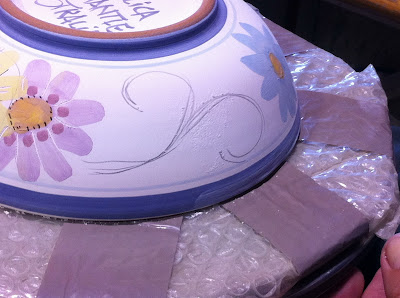I'm told that most galleries here won't accept work which uses the Japanese or Chinese printed tissue prints so popular in the last few years, due to the market being cornered by a handful of ceramists who excel in this method. So we are learning to make our own tissue prints - less perfect than bought ones but unique to the maker.
This week we covered Screen printing with Underglaze. The image has to be put onto a screen creating a stencil on the mesh for the 'ink' to be squeegeed through onto some tissue or clay. We covered the range of screen options, I favour Riso Screens (or Gocco) for their ease of availability from Jacksons Art Supplies here in WA. You just provide a PDF on a thumbdrive, email your image or simply hand it in to a Jacksons branch to get it made. We looked briefly at Diazo photo sensitive emulsion type options which would take a whole term of classes to teach well - and is sometimes taught at TAFE. We mentioned that there are screen prep services who'll take your silkscreen, expose your artwork onto the screen resulting in a very durable screen - permanent until you need a new design put on it.
 |
| image from NEHOC website |
For 'ink' options - we ran with mixing powdered underglaze and low melting fritt with a suitable print medium. For the medium I prefer, Derivan Print Gel, you can buy it in art shops or use honey or corn syrup or even condensed milk - as long as it can soak up and carry the pigment powder and screen it through the mesh. A Curtin Uni print student contributed the condensed milk suggestion. I am steering away from oil based media for now as the mess and cleanup might be off-putting. I'll post on that another time.
Ratios of pigment to medium depend on the composition of the powdered underglaze - and some are 'thirstier' than others. You want to create a densely pigmented syrupy 'ink'.
Ditto with the ratio of underglaze powder to fritt - some underglaze compositions melt more easily than others - so I unapologetically tell the class - there are no easy answers, you have to test test test! I am awaiting some premixed black ceramic ink to test right now from Northcote Pottery Supplies in Melbourne but that will be another post.
As for colour options, there are some superb premixed liquid underglazes available from Walkers, Cesco, Northcote, Duncan and Amaco to name a few brands. They come in a plethora of colours, but their viscosity is too low for use in screening. In fact these products can be used by rendering them thicker/more viscous through evaporation and that elusive ingredient - patience, of which I have heaps. Essentially most print on clay techniques are very similar to printing on paper or textiles, it is just the 'ink' that differs in composition as it has to survive being applied to clay - flat or otherwise, bonding to the surface and being fired. The best prints are 'just' screened and applied while the ink is still wet to some moist leatherhard clay. On Weds night we were only practicing on recently made slabs but the night was warm so they were stiffening up fast despite covering them with moist Chux/J-cloths prior to use. Transferring a recently made print on tissue paper onto a complex curve means trimming the tissue around the print area carefully for ease of application. In theory it is easy but in reality it takes an understanding of the process and some dexterity. Fortunately ceramic artists seem to thrive on developing these things.
I am preparing a short slideshow for my class next week, not something I'd usually do for an evening class but I want to inform and excite my students and 'set them on fire'.
Let's see what all the other potters are doing at http://mudcolony.blogspot.com.au
PLEASE NOTE: All text in this blog posting is copyright of Elaine Bradley, Ceramic Artist, Western Australia unless quoting from another source. All photographs in this blog posting are copyright of Elaine Bradley unless otherwise stated. No responsibility can be taken for external links. Please report any errors in crediting photographs, sources or facts to the author in order to allow her to rectify the matter. Your response or feedback is welcome.






































